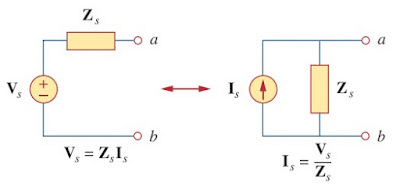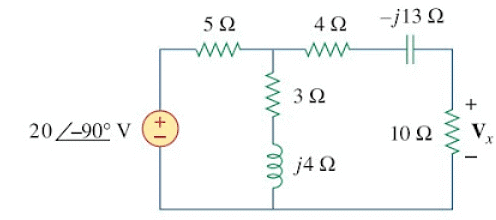Source Transformation in AC Circuits | Network Theory (Electric Circuits) - Electrical Engineering (EE) PDF Download
Source transformation in the frequency domain involves transforming a voltage source in series with an impedance to a current source in parallel with an impedance, or vice versa.
This method helps us to analyze the ac circuit with more than one independent sources.
 Source TransformationAs we go from one source type to another, we must keep the following relationship below:
Source TransformationAs we go from one source type to another, we must keep the following relationship below:

- The main idea of this method’s principle is to substitute voltage source in series with a resistor to a current source in parallel with a resistor or vice versa for dc circuit.
- Make sure to use impedance instead of the resistor when you analyze the ac circuit with this method.
- This theorem is developed by Jacob Millman. This method simplifies multiple parallel sources to an equivalent single resistor.
- This method is also used for a circuit with an unbalanced bridge circuit.
- This method is also known as Millman Theorem. This theorem is useful to simplify a circuit with multi-voltage sources or multi current sources to a single source.
- Even it has a unique name, this method also has its basic principle from Ohm’s Law and Kirchhoff’s Law.
- But you need to remember, this method only works on a circuit that can be redrawn accordingly.
- The polarity of all voltage sources in the circuit is referenced to the same point.
Note:
Can we apply source transformation on Dependent Source?
- Yes, you can apply source transformation techniques to circuits containing dependent sources, just as you would with independent sources. Source transformation is a common method used to simplify circuits by converting voltage sources to current sources or vice versa, and changing their associated resistors accordingly.
- Source transformations work for both dependent and independent sources, but the process can be a bit more complex when dealing with dependent sources, especially if their values depend on circuit variables. The general idea is to replace the original source with an equivalent source that simplifies the circuit while maintaining the same voltage and current relationships.
Let us cover the technique from the example below:
Example:
Calculate Vx in the circuit of Figure . using the method of source transformation
Solution:
We transform the voltage source to a current source and obtain the circuit in Figure. where
The parallel combination of 5 Ω resistance and (3 + j4) impedance gives
Converting the current source to a voltage source yields the circuit in Figure.
where,
Using voltage division,
|
76 videos|152 docs|62 tests
|
FAQs on Source Transformation in AC Circuits - Network Theory (Electric Circuits) - Electrical Engineering (EE)
| 1. What is source transformation in AC circuits? |  |
| 2. How does source transformation work in AC circuits? |  |
| 3. What are the benefits of using source transformation in AC circuits? |  |
| 4. Can source transformation be applied to both series and parallel AC circuits? |  |
| 5. Are there any limitations or considerations when applying source transformation in AC circuits? |  |
















